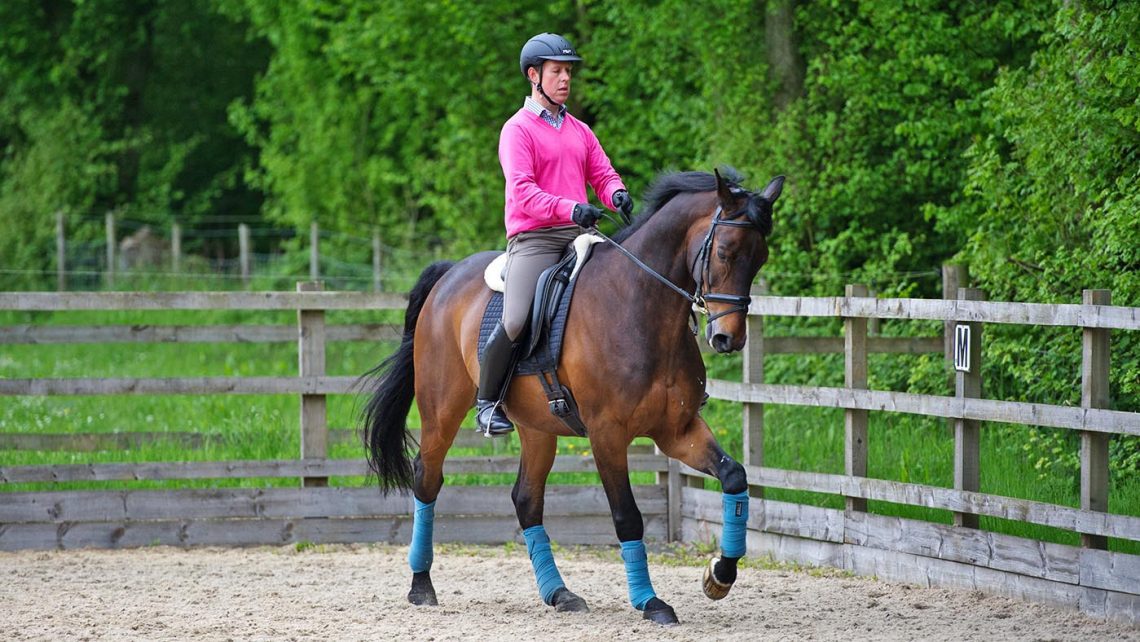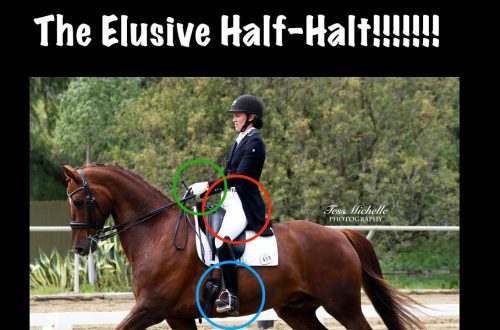
The Importance of Counter-Canter in Horse Training
The Importance of Counter-Canter in Horse Training
Counter-canter plays an important role in training your horse because it not only improves his natural canter, but also develops straightness and assists in the process of achieving collection.
The gallop is a gait in which the horse always has one leading foot (this in turn determines the outside and inside of the horse). The inside hind leg naturally carries more weight because it steps deeper under the horse’s body, closer to the center of gravity. In counter-canter, the focus is on helping the horse bring the outside hind leg under the body, thereby encouraging him to take more weight on that leg and move away from that leg while maintaining balance. The half halt helps to transfer weight to the hind legs. In this process, the horse’s body is aligned and closed. The counter canter is one of the few exercises that allows the rider to directly activate and engage the horse’s outside hind leg.
Normal canter – the inside hind leg takes more weight and steps deeper under the horse’s body, closer to the center of gravity.
In counter-canter, the focus is on helping the horse handle the weight being transferred to the outside hind leg, encouraging the horse to go deeper under the body with that leg and push harder. The counter canter is one of the few exercises that allows the rider to directly engage and activate the outside hind leg of the horse.
What should you feel?
The counter-canter should feel as good and collected as a regular canter: the rider sits lightly, in balance and feels the movement “uphill”. Since the horse is balanced, this allows the rider to maintain a correct seat (the rider’s inside seat bone on the leading side is lowered and the horse moves elastically on the outside rein). In this state, the horse is very susceptible to half halts, his shoulders are agile, so you can straighten him with your controls.
Alignment issues
Horse counter-canter should not only to move in front of the inside leg (left in a canter to the left), but also to correctly respond to the outside (right) leg – go straight from the influence of the outside leg, and not move the back to the side.
When you counter-canter in a straight line (like along the arena wall), you sit just like you would in a normal canter. But as you approach a corner or enter a circle, you need to push the horse’s shoulders inward and make sure the horse’s hind legs follow the trail of the front.
When I enter a turn, I imagine a ranvers and move the horse’s shoulders inward so he doesn’t think he has to move forward through the arena. But, unlike the ranvers, the horse must be held upright – his body must remain level, with the shoulders in front of the hips, with the neck centered. This is especially important because the horse’s hind legs must move in line with the front legs in order for the horse to move in a straight line.
A common problem riders have is the tendency to push the back of the horse with the outside leg. As a result, the horse’s hind legs move outward towards the wall of the arena, and the shoulders move inward. To counteract this tendency, you need to drive the horse forward with the outside leg.
When the horse is in front of the outside leg, he pushes off with his outside leg and sets it straight. For example, if you are cantering to the left with your right leg, you want the horse to push off his left leg and put it straight, not out of the way, from the impact of your left leg. As in a normal canter, the inside leg should be at the girth and the outside leg behind it. Check if the horse is elastic on the inside side, let him stretch and fill the outside rein. Then you can use it and, if necessary, adjust the shoulders in a new direction.
Here are some of my favorite counter canter exercises. I usually repeat the exercise three times to help my horse understand it.
Exercise 1. Introducing the Horse to Counter-Canter
First of all, I ask the horse not to change his leg when changing direction. In any case, we must provide the horse with a certain level of comfort appropriate to its level of training. Therefore, I choose lines that make it easy to change direction and return to the canter on the right foot.
You want the horse to maintain basic balance and feel comfortable coordinating movements.
So:
1. Move left at a normal canter along the long side of the arena from H to K.
2. On K, make a 10-meter half-volt and return to the wall on E.
3. At S, do a 20-meter semi-circle to R in counter canter.
4. Test 2 of Level Two, where we got this exercise from, tells you to do a simple change of foot to B, but you can change your foot diagonally and repeat the maneuver. Then do it in the other direction.
Exercise 2
1. Move to the left at a normal gallop along the long wall from H to K.
2. Pass the corner after K and go into step.
3. Step back a meter from the first quarter line, holding the left ruling.
4. Make a big arc on the back in the corner – it will take you to K. This turn on the back is done in such a big arc that you should have the feeling that you are doing a half pass. You could even call it a hybrid of a half-turn and a half-turn. Try this exercise in the early stages of learning to counter canter, as it teaches you the basics, especially sensitivity to external leg influences.
5. In K, hold the left ruling and pick up the left reins.
6. You now have two options: change the reins from E to M and repeat the exercise or, if your horse is more advanced, continue to counter canter on the long wall and short wall, change the reins between M and V and repeat the exercise.
Exercise 3
This exercise will help the horse understand the essence of the half halt and also teach him how to properly respond to the outside leg (to move in front of the outside leg). The shoulders should remain in front of the hips.
1. Move left in a right counter canter down the long wall to M.
2. Drive the line from M to H. At point G, stop after a walk (if your horse is ready for this, it will stop directly from the counter canter.).
3. Keeping the right posture, make a lateral movement to C. Maintain the correct position of your horse. This full lateral movement teaches the horse to obey the outside leg and keeps him in front of the inside leg.
4. On C, rein back about the length of the horse’s body or 3-4 paces.
5. Raise the horse into a right counter-canter and repeat the exercise at the other end of the arena. When reining in, the energy should flow directly back over the outside of the horse, providing a good transition into a normal canter.
Hold (movement to the side is not shown).
Restraining.
Normal gallop.
Exercise 4
Horses are usually better at counter-canter pirouettes. As you work through this exercise, you will find that the combination of the halfway with the counter canter will benefit both of you and improve your pirouettes.
1. Start moving to the left at a normal canter.
2. Pass the short wall and turn onto the second quarter line.
3. Half pass to the next quarter line and move straight to the short wall.
4. Turn right and drive straight down the quarter line, parallel to the long side of the arena.
5. Perform a traverse, keeping the horse’s forelegs in the quarter line, and shifting the hind legs to the left.
6. Then pick up the horse in preparation for the pirouette. What will be the fee depends on the level of training of your horse.
7. Then level the horse.
8. You now have two options: you can descend the next quarter line (still riding to the right) and repeat the traverses and pirouette, or do the exercise in the other direction.
The more you work, the easier it will be for the horse to counter-canter. Include other elements in your training process: turn on the back or pirouettes on the walk, 8- and 10-meter circles, transitions within the gaits. Try traversing and running on the walk After these exercises, horses become more responsive.
When you are focusing on your ability to develop your horse’s responsiveness, the counter-canter will help you pick it up.
However, before you introduce the horse to the counter-canter, you need to make sure that he understands the influence of the outside rein correctly and is well balanced in the walk-canter and canter-walk transitions. The upward transition from walk to canter helps the horse figure out how your aids work in terms of which foot he should be able to canter on (the horse is aware that the rider’s outside foot is telling him which foot to come up with and his inside is moving him forward). The horse learns to go forward on the right leg by combining the action of both legs. The downward transition from canter to walk is valuable because it teaches the horse to understand half halts and allows him to shift his weight back, which improves the carrying capacity of the hind legs. Before asking for a counter-canter, make sure the horse has the basic concepts and the ability to collect.
Counter-canter at the Fourth level (Test 3)
One of the reasons I think the counter canter is a great topic for this article is because the new Level Four Test 3 includes an old move from the Prix St. test. Georges, in which the horse must do a 10 meter half circle in collected canter and then a 10 meter half circle in counter canter. This element reminds us of the value of using circles in cantering.
To perform this element well, your horse’s shoulders must be agile in a new direction, and his hindquarters must be directly behind his shoulders. Your horse should show straightness on the center line. This movement, when done well, improves the degree of collection.
1. At C, lift the horse into a normal collected canter on the right leg.
2. RI – 10-meter half-volt.
3. IS -10-meter half-volt in counter-canter, air-to-air change to E.
4. VL half volt 10 meters.
5. LP Half Volt 10 meters counter-canter, mid-air change to F.
George Williams (source); translation by Valeria Smirnova.





